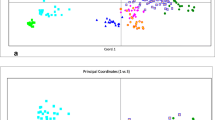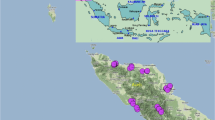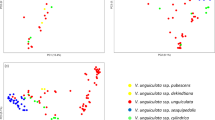Abstract
Cacao (Theobroma cacao L.) is the main source for chocolate with an annual production of four million tons worldwide. This Neotropical tree crop was domesticated in Mesoamerica as far back as 3,000 years ago. Knowledge of genetic diversity and population structure in farmer varieties of cacao in the center of domestication is essential for sustainable production of fine-flavored cacao beans and contributes to in situ/on-farm conservation of farmer varieties. Based on 70 single nucleotide polymorphism markers, we analyzed 84 fine-flavored farmer varieties collected from traditional cacao farms in Honduras and Nicaragua. The study also included 31 clones from the international cacao collections to serve as references. The SNP based multilocus matching identified six synonymous groups, including 14 Criollo and two Amelonado varieties. A moderately high level of genetic diversity was observed in these farmer varieties, indicating the possibility to further explore intra-population variation and breed for fine-flavored cocoa. Multivariate analysis showed clustering of the 84 farmer accessions in five genetic groups: ancient Criollo, Amelonado, Trinitario (including Nicaragua Trinitario and Honduras Trinitario) and Upper Amazon Forastero (only one accession). The Honduras Trinitario differed from the Nicaragua Trinitario group. The clustering results largely supported the perceived classification of cacao by local farmers and researchers, which was mainly based on morphological traits. However, the well known traditional variety “Indio” in this region was identified as synonymous with Amelonado. Parentage analysis showed that the variety “Indio” (or Amelonado) contributed more to the Trinitario type farmer varieties, whereas ancient Criollo had less influence. The present study demonstrates the efficacy of using a small set of SNP makers for cacao germplasm characterization, and further depicts the diverse origins and parentage in farmer varieties from Mesoamerica. This information thus will be highly useful for conservation and utilization of cacao germplasm from this region.


Similar content being viewed by others
References
Argout X, Fouet O, Wincker P et al (2008) Towards the understanding of the cocoa transcriptome: production and analysis of an exhaustive dataset of ESTs of Theobroma cacao generated from various tissues and under various conditions. BMC Genomics 9:512
Bartley BGD (2005) The genetic diversity of cacao and its utilization. CAB International, CABI Publishing, Wallingford
Bellon MR (2004) Conceptualizing interventions to support on-farm genetic resource conservation. World Dev 32:159–172
Boccara M and Zhang D (2006) Progress in resolving identity issues among the Parinari accessions held in Trinidad: the contribution of the collaborative USDA/CRU project. CRU Annual Report 2005, Cacao Research Unit, The University of the West Indies, St. Augustine, Trinidad and Tobago
Brush SB (2000) The issues of in situ conservation of crop genetic resources. In: Brush S (ed) Genes in the field. IDRC/IPGRI/Lewis Publishers, Ottawa\, p 300
Buckler ES, Thornsberry J (2002) Plant molecular diversity and applications to genomics. Curr Opin Plant Biol 5:107–111
Cheesman EE (1944) Notes on the nomenclature, classification and possible relationships of cocoa populations. Trop Agricult 21:144–159
Coe SD, Coe MD (1996) The True History of Chocolate. Thames & Hudson, London
Cope FW (1976) Cacao. Theobroma cacao L. (Sterculiaceae). In: Simmonds NW (ed) Evolution of Crop Plants. Longman, London, pp 207–213
Cuatrecasas J (1964) Cacao and its allies. A taxonomic revision of the genus Theobroma. Contributions from the United States National Herbarium 35:375–614. Smithsonian Institution Press, Washington, DC
De la Cruz M, Whitkus R, Gomez-Pompa A, Mota-Bravo L (1995) Origins of cacao cultivation. Nature 375:542–543
Dias LAS (2001) Origin and distribution of Theobroma cacao L.: A new scenario. In: Dias LAS (ed) Genetic improvement of cacao. Available at: http://ecoport.org/ep?SearchType=earticleView&earticleId=197&page=-2
Dieringer D, Schlötterer C (2003) Microsatellite analyzer (MSA)—a platform independent analysis tool for large microsatellite data sets. Mol Ecol Notes 3:167–169
Evett IW, Weir BS (1998) Interpreting DNA Evidence: Statistical Genetics for Forensic Scientists. Sinauer, Sunderland
Felsenstein J (1989) PHYLIP: phylogeny inference package (version 3.2). Cladistics 5:164–166
Ganal MW, Altmann T, Röder MS (2009) SNP identification in crop plants. Curr Opin Plant Biol 12:211–217
Gómez-Pompa A, Flores JS, Fernandez MA (1990) The sacred cacao groves of the Maya. Latin Am Antiq 1:247–257
Henderson JS, Joyce RA, Hall GR, Hurst WJ, McGovern PE (2007) Chemical and archaeological evidence for the earliest cacao beverages. Proc Natl Acad Sci USA 104:18937–18940
International Cocoa Organization (ICCO) (2010) The World Cocoa Economy: Past and Present. London, UK
Kalinowski ST, Taper ML, Marshall TC (2007) Revising how the computer program CERVUS accommodates genotyping error increases success in paternity assignment. Mol Ecol 16:1006–1099
Kennedy AJ (1995) Cacao, Theobroma cacao (Sterculiaceae). In: Smartt J, Simmonds NW (eds) Evolution of crop plants. Longman, London, pp 472–475
Lanaud C, Fouet O, Gramacho K, Argout X et al. (2006) A large EST resource for Theobroma cacao including cDNAs isolated from various organs and under various biotic and abiotic stresses. In: Proceedings of the 15th international cocoa research conference, San Jose, Costa Rica, pp 185–191
Lockwood G and Gyamfi MMO (1979) The CRIG cocoa germplasm collection with notes on codes used in the breeding programme at Tafo and elsewhere. Tech. Bull. 10. Cocoa Research Institute, Ghana, p 62
Marshall TC, Slate J, Kruuk LEB, Pemberton JM (1998) Statistical confidence for likelihood-based paternity inference in natural populations. Mol Ecol 7:639–655
Mooledhar V, Maharaj WW, O’Brien H (1995) The collection of Criollo cocoa germplasm in Belize. Cocoa Grower’s Bull 49:26–40
Motamayor JC, Lopez PA, Ortiz CF, Moreno A, Lanaud C (2002) Cacao domestication. I. The origin of the cacao cultivated by the Mayas. Heredity 89:380–386
Motilal L, Zhang D, Umaharan P, Mischke BS, Mooleedhar V, Meinhardt LW (2010) The relic Criollo cacao in Belize- genetic diversity and relationship with Trinitario and other cacao clones held in the International cocoa Genebank, Trinidad. Plant Genet Res Charact Util 8:106–110
Ogata N, Gomez-Pompa A, Taube KA (2006) The Domestication and Distribution of Theobroma cacao L. in the neotropics. In: McNeil CL (ed) Chocolate in Mesoamerica: a cultural history of cacao. University Press Florida, Gainesville, pp 69–89
Peakall R, Smouse PE (2006) Genalex 6: genetic analysis in Excel. Population genetic software for teaching and research. Mol Ecol Notes 6:288–295
Pound FJ (1945) A note on the cocoa population of South America. In: Report and proceedings of the 1945 cocoa conference, London, pp 131–133
Powis TG, Cyphers A, Gaikwad NW, Grivetti L, Cheong K (2011) Cacao use and the San Lorenzo Olmec. Proc Natl Acad Sci USA 108:8595–8600
Rafalski A (2002) Applications of single nucleotide polymorphisms in crop genetics. Curr Opin Plant Biol 5:94–100
Saitou N, Nei M (1987) The neighbor-joining method: a new method for reconstucting phylogenetic trees. Mol Biol Evol 4:685–691
Saunders JA, Mischke S, Leamy EA, Hemeida AA (2004) Selection of international molecular standards for DNA fingerprinting of Theobroma cacao. Theor Appl Genet 110:41–47
Smith N (1999) The Amazon River Forest: a natural history of plants, animals, and people. Oxford University Press, USA
Sounigo O, Umaharan R, Christopher Y, Sankar A, Ramdahin S (2005) Assessing the genetic diversity in the International Cocoa Genebank, Trinidad (ICG,T) using isozyme electrophoresis and RAPD. Genet Resour Crop Evol 52:1111–1120
Toxopeus H (1985) Botany, types and populations. In: Wood GAR, Lass RA (eds) Chapter 2 in cocoa 4th edition. Blackwell Science, Oxford, pp 17–18
Trognitz B, Scheldeman X, Hansel-Hohl K et al (2011) Genetic population structure of cacao plantings within a young production area in Nicaragua. PLoS ONE 6:e16056
Van Hall CJJ (1914) Cocoa. Macmillan, London
Waits LP, Luikart G, Taberlet P (2001) Estimating the probability of identity among genotypes in natural populations: cautions and guidelines. Mol Ecol 10:249–256
Young AM (2007) The chocolate tree: a natural history of cacao. University Press of Florida, Gainsville, FL
Zhang D, Mischke S, Goenaga R, Hemeida AA, S’A (2006) Accuracy and reliability of high-throughput microsatellite genotyping for cacao clone identification. Crop Sci 46:2084–2092
Zhang D, Mischke BS, Johnson ES, Mora A, Phillips-Mora W, Meinhardt LW (2009) Molecular characterization of an International cacao collection using microsatellite markers. Tree Genet Genom 5:1–10
Zhang D, Figueira A, Motilal L, Lachenaud P, LW Meinhardt (2012) Theobroma. In: Kole C (ed) Wild crop relatives: genomic and breeding resources, plantation and ornamental crops. doi:10.1007/978-3-642-21201-7_13; Springer, Berlin, pp 277–296
Acknowledgments
We thank Xavier Argout, Claire Lanaud and Mathilde Allegre of CIRAD, France for providing the SNP marker sequences. We also thank Shenghui Duan and Cindy Helms of the Human Genetics Division Genotyping Core, Washington University School of Medicine for SNP genotyping. We are grateful to TechnoServe for providing cacao leaf samples and passport data.
Author information
Authors and Affiliations
Corresponding author
Rights and permissions
About this article
Cite this article
Ji, K., Zhang, D., Motilal, L.A. et al. Genetic diversity and parentage in farmer varieties of cacao (Theobroma cacao L.) from Honduras and Nicaragua as revealed by single nucleotide polymorphism (SNP) markers. Genet Resour Crop Evol 60, 441–453 (2013). https://doi.org/10.1007/s10722-012-9847-1
Received:
Accepted:
Published:
Issue Date:
DOI: https://doi.org/10.1007/s10722-012-9847-1




